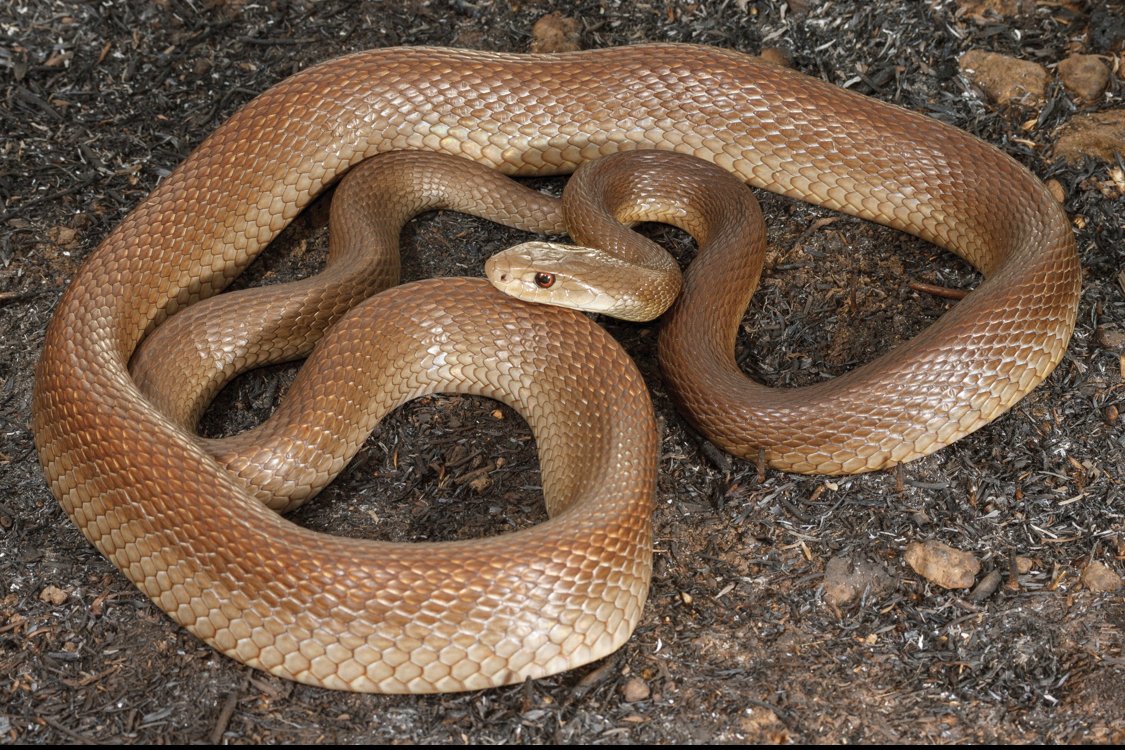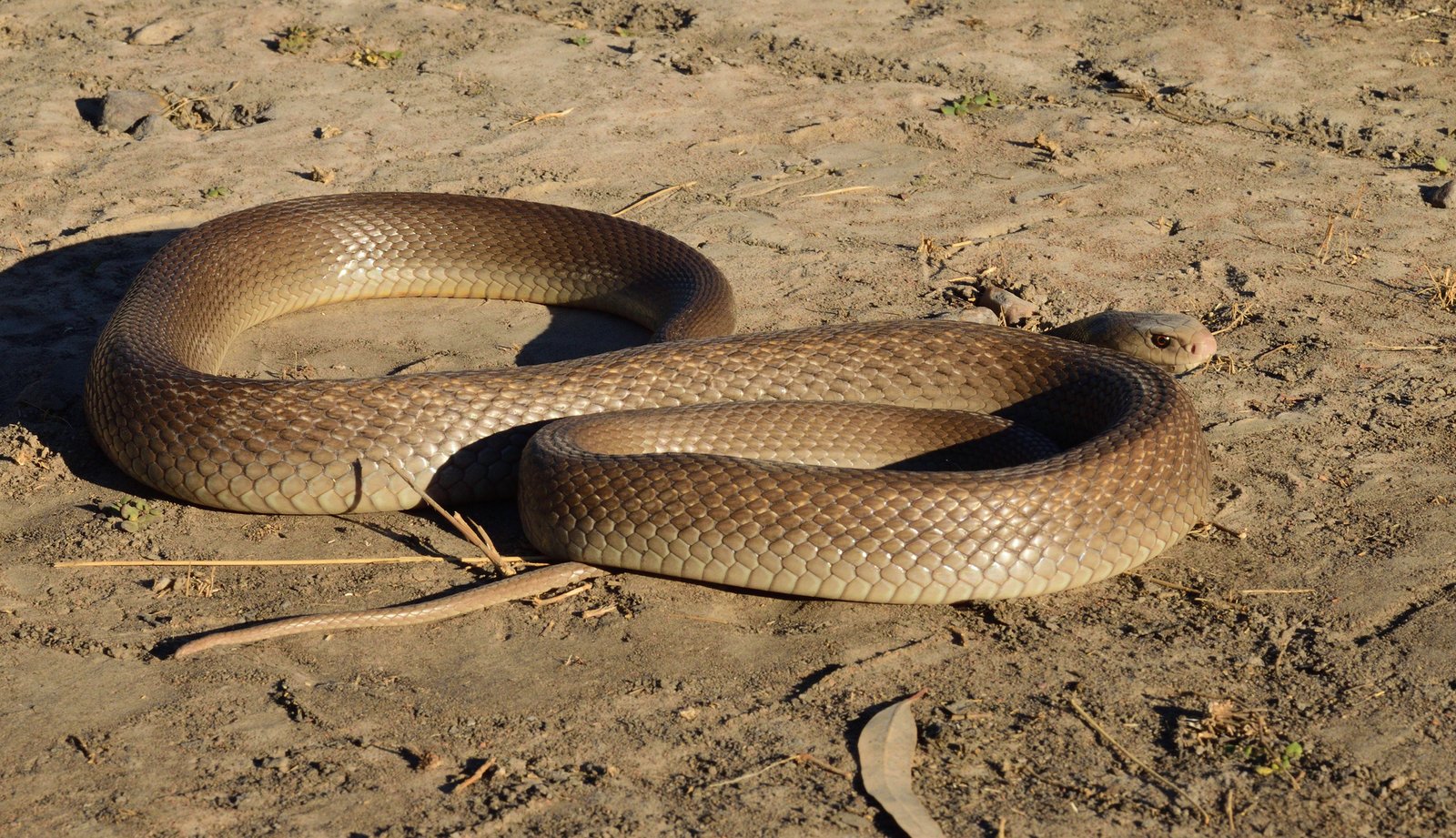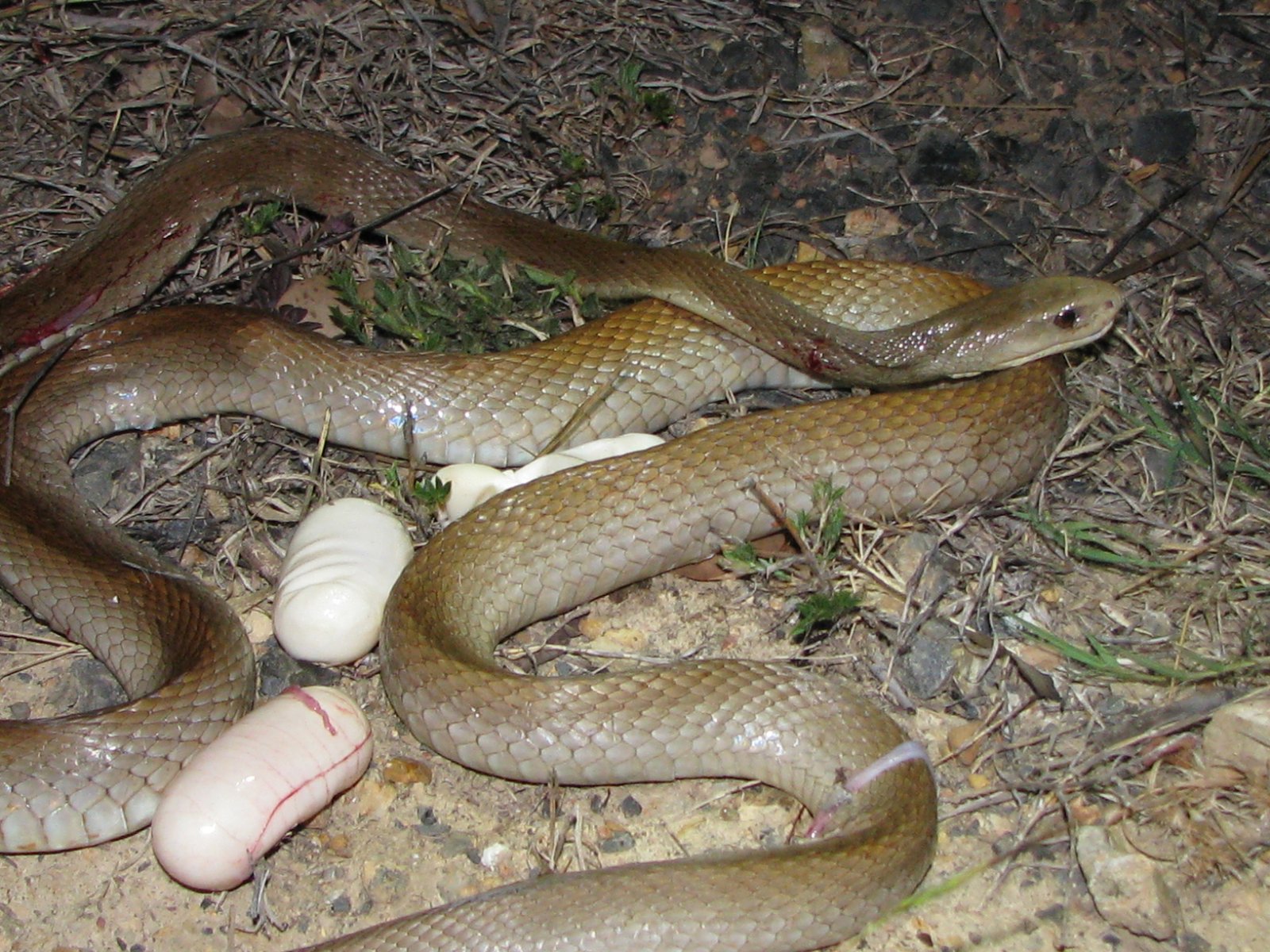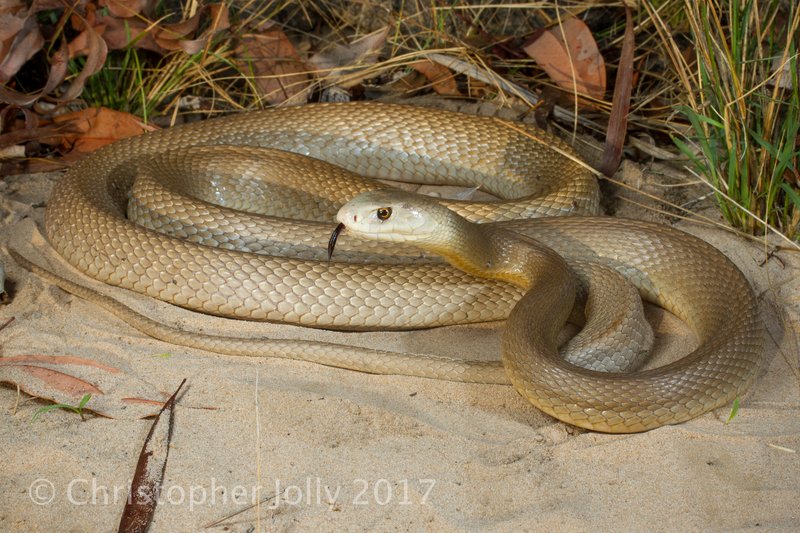Coastal Taipan
Eastern Taipan. The word ‘Taipan’ is the name given to this species by the Wik-mungkan people of Cape York. It was introduced into general use by the anthropologist Dr Donald Thomson (who was also the first man to capture and milk a live Taipan).
This species is sometimes confused with one of several large brown-coloured elapids, such as the Eastern Brown Snake Pseudonaja textilis, Western Brown Snake P. nuchalis, and the Mulga Snake Pseudechis australis. The Taipan is usually distinguished by its pale face and snout, large head and slender neck (in brown snakes and mulga snakes the face/snout is usually the same colour as or darker than the body, and the smaller head is as thick as the neck or only slightly distinct).
Introduction
Confident in its own splendid lethality, the Coastal Taipan is not one to back away from a close or surprise encounter. However, given the chance (and plenty of space), this maligned and misunderstood snake will always prefer a vanishing act over a showdown.
What do Coastal Taipans look like?
Identification
A medium to large snake, with a robust build and a deep, rectangular-shaped head distinct from the slender neck. Body colour may be yellowish, reddish brown, dark brown or almost black. The species undergoes a seasonal change in colour, with individuals becoming darker in winter and fading in summer. The head is noticeably paler than the body, particularly in juveniles (the head will darken with age however the snout always remains pale). Dorsal scales may be slightly keeled, at least on the neck, otherwise smooth. The ventral surface is yellowish to cream with scattered orange blotches. Eyes are large, with an intense orange-brown iris and round pupil.
Midbody scales in 21 or 23 rows, ventrals 220-250, anal scale single, subcaudals divided.
Average length around 2m (total), with males growing slightly larger than females. The Coastal Taipan has been reported to grow to over 3 metres, however the largest wild-caught museum specimen reliably measured was a male with a snout-vent length of 2260mm. A huge captive bred Taipan donated to the Queensland Museum had a snout-vent length of 2425mm and a total length of 2900mm.

© CC BY-NC 4.0
Where do Coastal Taipans live?
Habitat
Found in warm wetter temperate to tropical coastal regions, in monsoon forest, wet and dry sclerophyll forest and woodland, and in natural and artificial grassy areas including grazing paddocks, disused rubbish tips and cane fields, where there is often an abundance of rats. Thickets of introduced lantana are also favoured habitat. The Coastal Taipan shelters in abandoned animal burrows, hollow logs and in piles of vegetation and litter.
Distribution
The Australian subspecies Oxyuranus scutellatus scutellatus ranges in an arc along the east coast from northeastern New South Wales through Queensland and across the northern parts of the Northern Territory to northern Western Australia. The other subspecies, Oxyuranus scutellatus canni, occurs in southern New Guinea.
What do Coastal Taipans eat and how have they adapted?
Feeding and diet
In the wild, Coastal Taipans are known to feed only on warm-blooded prey, i.e. mammals, such as mice, rats, bandicoots, and birds. Young Taipans, in captivity at least, will also eat skinks. When hunting, the Taipan appears to actively scan for prey using its well-developed eyesight, and is often seen travelling with its head raised above ground level. Once prey is detected the snake ‘freezes’ before hurling itself forward and issuing one to several lightning-fast bites. The prey is released and allowed to stagger away - this strategy minimizes the snake’s chance of being harmed in retaliation, particularly by rats which can inflict lethal damage with their long incisors. After a few moments the Taipan tracks down the dying animal by following the scent trail with its flickering tongue.

© CC BY-NC 4.0
Other behaviours and adaptations
Coastal Taipans are primarily diurnal, being mostly active in the early to mid-morning period, although they may become nocturnal in hot weather conditions.
In captivity, the species changes colour with the seasons, becoming a bright coppery colour in summer and dull brown in winter. Presumably the change helps the snake to warm up quickly during the cooler months (when darker) and avoid overheating in the warmer months (when lighter). Interestingly, juvenile snakes do not appear to undergo this seasonal change.
Seasonality
Coastal Taipans are active throughout the year, however they are most commonly encountered in late winter and spring.
Specimen in our collection
View microCT scans of a Coastal Taipan (Oxyuranus scutellatus) from the Australian Museum Herpetology Collection (specimen AM R.47468). Learn more about microCT scanning and how it is used by the Australian Museum Research Institute.
How do Coastal Taipans mate?
Breeding behaviours
Studies of museum specimens have found oviducal eggs in females from late August to mid-November, and gravid females have been observed basking in the ‘windrows’ of cane fields from August to September. Mating in captive Coastal Taipans also appears to peak in late winter/early spring (although they can be encouraged to breed almost all year round). Behaviour presumed to be male combat has been reported in wild (unsexed) Taipans. Combat usually involves two males entwining their bodies and ‘wrestling’ to push down the other’s head and neck. How a ‘winner’ is determined remains unclear, however by defeating and driving away competitors the successful male presumably gains greater access to any receptive females in the area.
Courtship observed in captive Coastal Taipans appears to follow the basic pattern seen in many other snake species. Upon encountering a receptive female the male becomes highly excited and moves up and along the body of the female, continually tongue-flicking and rubbing his chin against her. In captivity, copulation has lasted as long as three hours and 20 minutes.
Taipans are oviparous (egg-laying). Two to three months after mating the female will lay between 3 and 21 soft-shelled eggs (average of 11), usually in a log hollow, under tree roots or in cavities in the ground. In captivity females often produce a second clutch many weeks after the initial mating – this suggests the female may be able to store sperm for several months.
Depending on the incubation temperature the eggs hatch between two and three months after being laid. The emerging young measure around 46cm (total) and are fully equipped to hunt and begin their solitary lives. Taipans hatched in captivity grow incredibly fast, and can reach to over a metre in their first year. Growth rates for wild Taipans are not known, however the lack of small specimens in museum collections may suggest that the species grows rapidly under natural conditions as well.

© CC BY-NC 4.0
Predators
Newly-hatched and immature snakes have a number of natural enemies, including various birds of prey and goannas. Few predators would take on a large adult Coastal Taipan, however people still routinely kill them on sight.
The species’ only recorded parasites are nematodes (round worms).
Are Coastal Taipans dangerous to humans?
Danger to humans
The Coastal Taipan is often regarded as the most dangerous snake in Australia. They are extremely nervous and alert snakes, and any movement near them is likely to trigger an attack. Like any snake the Taipan prefers to avoid conflict and will quietly slip away if given the chance, however if surprised or cornered it will ferociously defend itself. When threatened, the Coastal Taipan adopts a loose striking stance with its head and forebody raised. It inflates and compresses its body laterally (not dorso-ventrally like many other species) and may also spread the back of its jaws to give the head a broader, lance-shaped appearance. Invariably the snake will strike, often without any warning, inflicting multiple snapping bites with extreme accuracy and efficiency. The muscular lightweight body of the Taipan allows it to hurl itself forwards or sideways and reach high off the ground, and such is the speed of the attack that a person may be bitten several times before realizing the snake is there.
The venom apparatus of the Coastal Taipan is well developed. The fangs are the longest of any Australian elapid snake, being up to 12mm long, and are able to be brought forward slightly when a strike is contemplated (the fangs of elapids are generally short and ‘fixed’ in position). When the Coastal Taipan strikes it injects a large amount of highly toxic venom deep into the flesh, and studies have shown they are capable of injecting the same amount in a second or third bite. The venom affects the nervous system and the blood’s ability to clot, and victims may experience headache, nausea/vomiting, collapse, convulsions (especially in children), paralysis, internal bleeding, myolysis (destruction of muscle tissue) and kidney damage. The onset of serious symptoms is often rapid, so anyone suspected of receiving a bite must seek medical attention immediately, no matter how trivial the bite may appear. Prior to the introduction of specific antivenom by the Commonwealth Serum Laboratories in 1956, a Taipan bite was nearly always fatal.
References
- Barnett, B. (1986) "The Taipan in Captivity", Thylacinus 11(1): 9-19
- Cogger, H. (2000) “Reptiles and Amphibians of Australia”, Reed New Holland
- Greer, A.E. (2006) “Encyclopedia of Australian Reptiles : Elapidae”, Australian Museum
- Ehmann, H. (1992) “Encyclopedia of Australian Animals : Reptiles”, Australian Museum, Angus & Robertson
- Masci, P. and Kendall, P. (1995) “The Taipan – The World’s Most Dangerous Snake”, Kangaroo Press
- Mirtshin, P. and Davis, R. (1991) “Dangerous Snakes of Australia”, revised edition, Ure Smith Press
- Shine, R. and Covacevich, J. (1983) “Ecology of the Highly Venomous Snakes : the Australian Genus Oxyuranus (Elapidae)”, Journal of Herpetology, 17:60-69
- Wilson, S. and Swan, G. (2008) “A Complete Guide to Reptiles of Australia”, Reed New Holland


